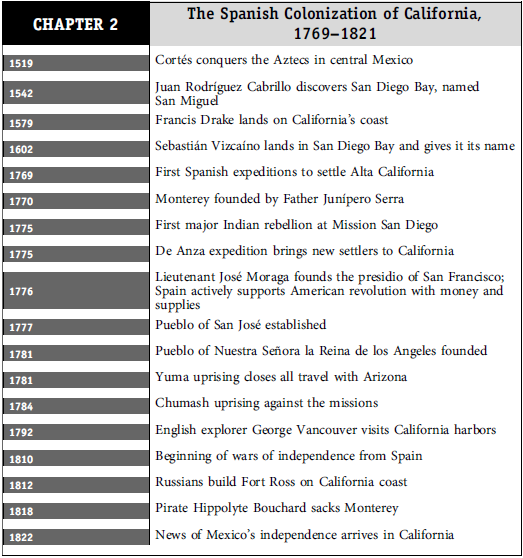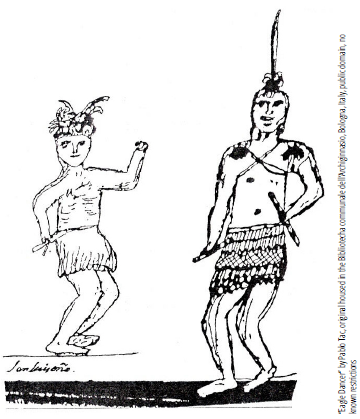2: The Spanish Colonization of California, 1769–1821
- Page ID
- 126944
Main Topics
- The Spanish Conquest and Empire
- Demographic and Ethnic Growth of California
- Establishing Presidios and Pueblos
- Gender Relations in Spanish California
- Political Developments in Spanish California
- Summary
Pablo Tac was a Luiseño Indian (Quechnajuichom) born in Mission San Luis Rey in 1822. He came from a family of six children, most of whom had been born at his people’s ranchería (small settlement) near the mission. In 1832, Father Antonio Peyri chose Pablo and another boy to travel with him to Mexico City to study for the priesthood. They arrived at the College of San Fernando, where Tac lived until 1834, when Father Peyri took both boys to Spain and then to Rome for further education financed by the church. In Rome, the older boy died but Tac finished his education, studying humanities, philosophy, and rhetoric. He took his preliminary vows in 1839, intending to go back to California as a missionary, but he died before he could return. While in the seminary, Tac was asked to prepare a grammatical description of the Luiseño language and a dictionary. In addition to this document he wrote a history of his people and a

description of life in the missions, the only account written by a former neophyte. This rare document gives us an interpretation of history through the eyes of a Christianized California Indian, but we should be cautious about relying too much on his memories of his Indian past—they are in the context of his newly found religion and his probable desire to please his European mentors. At the same time, however, some scholars have analyzed the themes of resistance embedded in his narrative. Tac recalled his people’s history of warfare with the Kumeyaay peoples to the south before the Spaniards arrived. They were always at war with tribes that did not speak their language: “Always strife day and night,” he wrote. He also described their war practices. “They would surprise the enemy either when they were sleeping or when the men were

This drawing is one of two done by Pablo Tac and used to illustrate his essay "Conversion of the San Luiseños of Alta California" which he wrote while in Rome. It shows two young painted men performing a traditional dance holding rattles and dressed ceremonially in feathered skirts and head dress. They are indentified as "San Luiseños" and appear to be enjoying the occasion
leaving the house, the women remaining alone; and they would kill the women, old people, and children. This done, they burned the camp, fleeing to their homes.… In this miserable state they lived until merciful God freed us of these miseries through Father Antonio Peyri, a Catalan, who arrived in our country in the afternoon with seven Spanish soldiers.”
Tac related stories about the arrival of the first Spanish in his village and their attempts to speak to the Indian leaders. According to Tac, they were told, “What is it that you seek here? Get out of our country!” Tac continued, “It was a great mercy that the Indians did not kill the Spanish when they arrived, and very admirable, because they have never wanted another people to live with them, and until those days there was always fighting.”
Tac remembered that the priest appointed native alcaldes, who were more proficient in Spanish; each was given a staff of authority. At Mission San Luis Rey there were seven alcaldes. The priest communicated with the Indians through the alcaldes, who in turn carried the news to their villages. The laborers at the mission were accompanied by a Spanish majordomo and the alcaldes, whose purpose was “to hurry them if they are lazy…and to punish the guilty or lazy one who leaves his plow and quits the field.” And, regarding the priests: “In the Mission of San Luis Rey de Francia the Fernandino Father is likea king. He has his pages, alcaldes, majordomos, musicians, soldiers, gardens, ranchos, livestock, horses by the thousand, cows, bulls by the thousand, oxen, mules, asses, 12,000 lambs, 200 goats, etc.”
Pablo Tac died on December 13, 1841, before he could be ordained a priest; he was not yet 20 years old. His written work is the only account of California mission life written by an Indian, and it is also the first literature published by a California Indian.
Tac’s life story dramatizes the major changes that the Indians experienced as they encountered the Euro-American settlers. The goal of the Spanish priests and soldiers was to convert and pacify thousands of native peoples who lived near the California coast. They hoped to make the natives into loyal Spanish Catholic subjects, with the California missions at the core of the Spanish project to settle California. There were some successes, as evidenced in Tac’s narrative, but by and large the process of Hispanicization resulted in the introduction of new diseases that decimated the Indian population; however, by introducing the Spanish language, culture, and political system the Europeans added new diversity to an already heterogeneous society. The mixture of cultures would produce a resilient frontier environment—one that prepared California for new challenges.
Questions to Consider
- How and why did the Spanish finally settle Alta California?
- What were the characteristics of the society that they sought to create?
- How can we evaluate the debate over the modern interpretations of the California missions?
- What was the status of women in this colonial society?
- What was the influence of other Europeans on California's history?
- What is the importance of the Spanish era?


